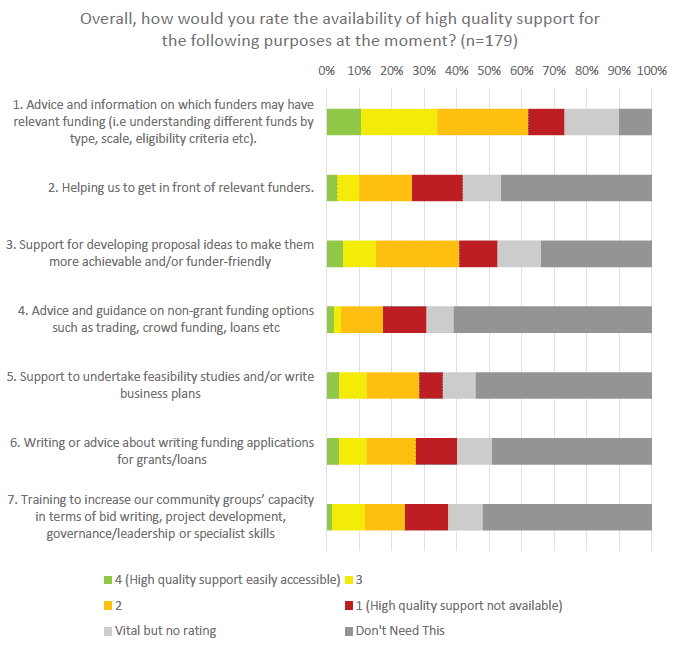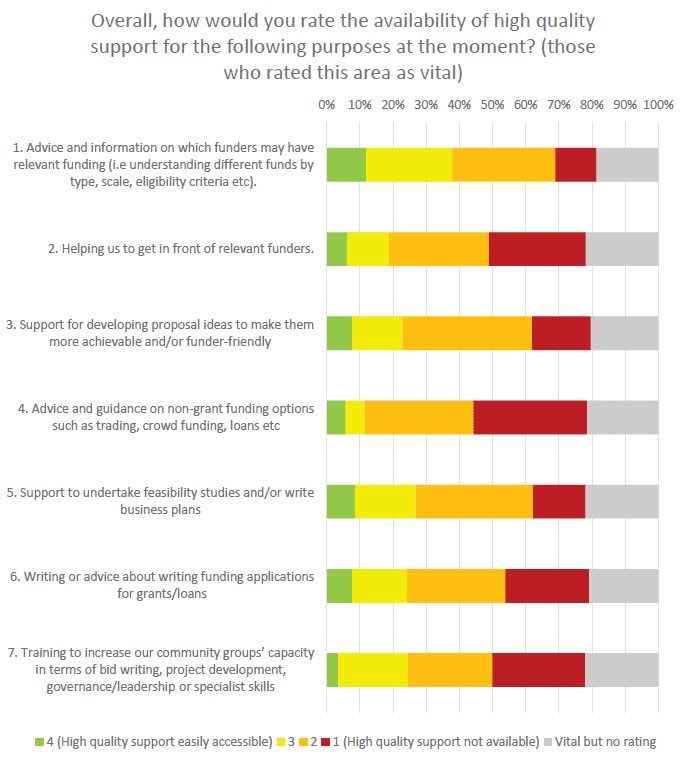Future Support and Advice to Rural Communities
This report explores the nature and level of existing support and advice available to rural communities in Scotland.
5 REFLECTION ON NEEDS AND CURRENT SUPPORT: WHERE ARE THE GAPS?
5.1 Figure 17 draws together the research described in the previous chapter on community groups' needs and available support. In it we present community groups' overall ratings of the availability of high quality support over the seven identified areas of funding advice and support.
Figure 17: Community groups' ratings of the availability of high quality support

5.2 Clearly, needs are complex and diverse. All the categories were considered 'vital' by at least ~40% of respondents. Furthermore, across all categories, community groups do not feel that their needs are being met with high quality support; fewer than 50% of people who said something was vital to groups like theirs and rated the support felt that it was of high quality (i.e. rated the availability of a high quality of support as 3 or 4).
5.3 Advice and information on sources of relevant funding was the most sought after area of help, and this was also the highest rated in terms of availability of high quality support (but still less than 50% rating as 3 or 4).
5.4 Similarly, fewest people thought that advice on non-grant funding options is vital, and this was the lowest rated in terms of availability of high quality support (15% of those who said this was vital and who rated support rating this as 3 or 4).
5.5 Help to get in front of relevant funders was also poorly rated (24% of those who said this was vital and who rated support rating it as 3 or 4). This association between the demand for services and the perceived quality of the services may simply reflect the extent to which providers are experienced and knowledgeable.
5.6 Figure 17a below omits those who felt they did not need each service. This shows the availability of high quality services more accurately - with all services except advice and information scoring under 30% for quality (ie rated as 3 or 4).
Figure 17a: Community groups' ratings of the availability of high quality support (omitting those who felt they didn't need the service)

Reflections with funding advice providers on the research around gaps in support
5.7 At the two advice provider workshops we reflected on gaps in support with advice providers. Some participants were surprised to see that, with such a wide array of support available, community groups' needs were not being met. While some delegates stated that community groups may have exaggerated what they feel they need, others said that advice providers may also have exaggerated what they are able to deliver.
5.8 Again, a key concern for participants was around the issue of quality. In particular, delegates at one workshop were keen to point out that community groups' answers in Figure 17 could be a result of three things:
- A genuine lack of high quality support
- Community groups' lack of awareness about existing high quality support
- Community groups' lack of access to high quality support of which they are aware.
It is not possible to use our research to tease out the relative importance of these three possibilities, but there is evidence of all three explanations being true to some extent:
- At the two workshops delegates reported that the quality of support provided is variable (for example, within and between Third Sector Interfaces)
- As we shall see in Chapter 5, many community groups were unaware of the range of services offered by Rural Direct
- Community groups cited transport difficulties in accessing events which they felt would be useful to them.
5.9 We emphasise that the issue of reported variable quality of provision, and how this consideration should supplement the mapping work in this research, was central to our reflections in the workshops and is reflected in our final recommendations.
Contact
Email: Liz Hawkins
There is a problem
Thanks for your feedback